communication
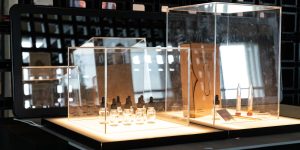
Organic Primitive Bioplastics
Primitive Labs Biodesign (US)
Organic Primitive Bioplastics challenges endless data accumulation and memory by posing an ephemeral paradigm for interacting with objects, driven by organic intelligences. Using a library of biomaterials to give objects a “voice” to communicate, everyday things are transformed into ephemeral information displays that change color, odor, and form in response to fluids.
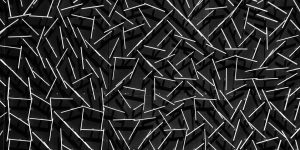
Putting the Pieces Back Together Again
Ralf Baecker (DE)
The kinetic installation Putting the Pieces Back Together Again is a complex system with self-organizing and emergent behavior. It is also an artistic inquiry and meditation on contemporary scientific methodology. The installation investigates non-hierarchical communication and collective behavior by implementing such a system physically through many electro-mechanical actors.
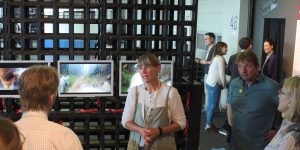
SLAP – See Like A Pony
Sabine Engelhardt (DE)
With SLAP I want to make robotics not only understandable but truly approachable. Clifford Nass drew the comparison of robots with domesticated animals. They are useful, but also dangerous. But, how do we communicate with animals? Can we feel them? How does it work?
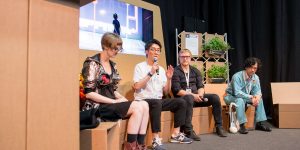
FUNGUAGE - the FUN spirit in the future
Panel Discussion
What is the future of playfulness? How can we work on this future in the present, in the midst of our current societies? At the Panel Discussion FUNGUAGE - the FUN spirit in the future, these questions will be examined, using the example of a shared research project between BANDAI NAMCO Research Inc., Hakuhodo and the Ars Electronica Futurelab - FUNGUAGE. FUNGUAGE is a new form of language that enables humans and non-living material to communicate more effectively, creating a speculative scenario that uses FUN as a universal language, transcending cultural boundaries.
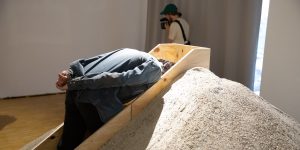
Drosophila Karaoke Bar
Ursula Damm (DE)
Drosophila Karaoke Bar invites visitors to establish a direct exchange with fruit flies through a technical interface that invites visitors to talk and sing with the flies.
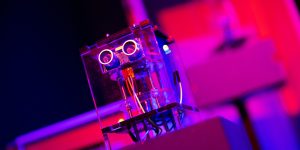
Sounds, and sweet airs
Kornbongkoch Harnpinijsak (TH), Weichen Tang (CN), Nong Hua Lim (MY)
This sensory design project reflects on natural sound ecologies to create a synthetic environment around human-technology interaction. It encourages us to rethink our relationship with the environment.
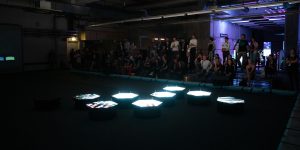
SwarmOS Research Demo
Swarm Arena
At the SwarmOS Research Demo, the Ars Electronica Futurelab will give a concept demonstration of their current research progress around swarm-based technology as a means of communication, which can be controlled with the in-house developed software SwarmOS. Whether it be stunning visualizations, real-time transmissions, new approaches to interaction design, artistic expression or unprecedented community experiences, the demonstration shows insights into the many applications possible through SwarmOS.
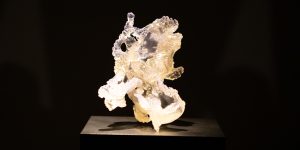
The Eye of the Other
MAEID – Daniela Mitterberger (AT), Tiziano Derme (IT/AT)
The Eye of the Other delves into non-verbal communication between humans and bats, through the study, translation and manipulation of the bat’s echolocation. This multimodal immersive artwork derives from the desire to transcend the limitation of our living experience by exploring the deeper meaning of mutualistic relationships and interspecies communication between humans and animals, juxtaposing the animals’ gaze and the human gaze.
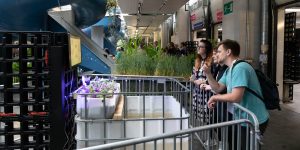
TeleAgriCulture_Rhizomatic Bias
Julian Stadon (AU), Erik Overmeire (NL), Daniel Artamendi (ES), V2_ Lab for Unstable Media (NL)
What happens if biotopes start chatting to each other using social network communication models? TeleAgriCulture_Rhizomatic Bias aims to explore how bias grows in machine learning and intelligent systems. This artistic provocation points at the much larger problems we face when our emotional biases and social constructions affect the way artificial intelligent systems evolve and impact our lives.
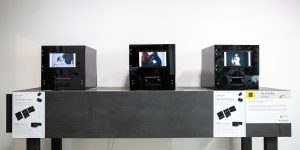
PSEUDOREALITY ALTERNATIVES
Cheung Kong School of Art and Design – Digital Media Art Department, Shantou University
Worldwide human society is moving from the digital to hyper digital age where virtuality is becoming as important as reality. Interpersonal communication is largely happening within a pseudo-real social landscape recently enriched with new artificial intelligence. However, we still find it confusing to navigate our existing social environment and understand each other clearly on different levels such as cultural, emotional, intellectual, and interpersonal. Through the works exhibited by Cheung Kong School of Art and Design, students are trying to communicate ideas of multiple understandings and misunderstandings, subtle and alternative meanings, and how that can affect our social and emotional realities. As artists and descendants of the Bauhaus, we recognize that our role is changing. We no longer believe in the heroic genius of the master who forms the world in a state of intuition. Embedding and feedback reveal that responsible action requires diverse cognitive variations that involve the counterpart in a performative way.


